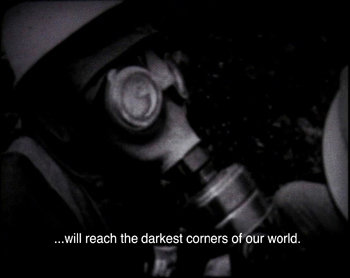Interstitial Zones
dal 17/10/2008 al 2/1/2009
Segnalato da
Francois Bucher
Guy Debord
Sebastian Diaz Morales
Christoph Draeger
Claire Fontaine
Joan Fontcuberta
Jean-Luc Godard
Armin Linke
Gianni Motti
Melik Ohanian
Shelly Silver
Julia Meltzer
David Thorne
Aldo Tambellini
Klaus vom Bruch
Paul Willemsen
17/10/2008
Interstitial Zones
Argos - Centre for Art and Media, Bruxelles
Historical Facts, Archaeologies of the Present and Dialectics of Seeing. The project offers a critical alternative or opposing space, with the work of fifteen artists that have sought out the crooks and crannies of post-war history that the mass media never reveal. The meta-narrative breaking up of the mechanisms of media representation and seeking out intervals make up the starting point of the exhibition. The show not only breaks open several decades of history by placing a distorted mirror before the mass media, it also focuses attention on that which transcends the moving image. Curated by Paul Willemsen.

Curated by Paul Willemsen
In the media, historic events obey the laws of the media. They are simplified and misrepresented in single dimension. The false economics of current events and info-entertainment that govern the news grind reality up. Reality no longer has anywhere to flee. We see either clichés (the repetition and proliferation of the same thing, over and over) or we see nothing at all (discrimination against context and background, or censure). In both cases, there is a form of blindness whereby the world can no longer be looked at and the viewer is shipwrecked. The media knows only the here and now, that which is fleeting and bears no inner memory. The media shows facts over which we have no power.
Interstitial Zones offers a critical alternative or opposing space, with the work of fifteen artists that have sought out the crooks and crannies of post-war history that the mass media never reveal. The topics are diverse: The Red Army Faction or RAF, George Bush's inaugural speech, the Clinton-Lewinsky affair, 9/11, Iraq, the extra-legal regime of the Guantánamo Bay detention centre, the assault on Salvador Allende, the Gaza conflict, religious suicide attacks and so on. These specific historic events could equally be exchanged for others. The meta-narrative breaking up of the mechanisms of media representation and seeking out intervals make up the starting point of the exhibition. These intervals manifest themselves, for example, in voice-overs detached from the visual presentation, interchanging multiple time spans and the use of black or white monochrome images.
As a result, a dialectic is set in motion between representations by the mass media on the one hand – with all the consequences for the way they take hold in our collective memories – and an ecological/iconoclastic position synonymous to the singularity of the artist on the other hand. Inherent to the interstitial space is the fact that it is a space of possibilities, a place where a new, different kind of visibility is put into effect. Interstitial Zones wishes to make a stand against the politics of invisibility with which the media confront us on a daily basis. How can we possibly speak of 'eimages' when the surfeit of finformation' is such as it is? How might we again retrieve the rational from the emotional, the sensational? How do we touch on new political conditions if they continue, by definition, to be a blind spot for the media?
The exhibition not only breaks open several decades of history by placing a distorted mirror before the mass media, it also focuses attention on that which transcends the moving image. It is now about the eclipse of politics and aspects of negative democracy, notably that which has increasingly pulled away from electoral legitimacy. The French language has the semantic attraction of offering a word play on the words voir and savoir, to see and to know, which did not escape Jean-Luc Godard. This same dialectic is also fundamental to the Interstitial Zones exhibition, where seeing is enclosed within knowing, in an ever-changing matrix of conscious and subconscious recollections. This means that the viewer has an active role in the exhibition. In contrast to the inherent character of television or film, the medium here does not disappear in what it permits us to see, but shows itself for what it is. The dialogue between different kinds of images provides an important place for that which cannot be visualized, but which is certainly conceivable.
Curated by Paul Willemsen with contributions by: François Bucher, Guy Debord, Sebastian Diaz Morales, Christoph Draeger, Claire Fontaine, Joan Fontcuberta, Jean-Luc Godard, Armin Linke, Gianni Motti, Melik Ohanian, Shelly Silver, Julia Meltzer and David Thorne, Aldo Tambellini, Klaus vom Bruch and et alia.
Image: Christoph Draeger, Helenés - Apparition of Freedom, 2005. Courtesy the artist.
Opening Sat 18.10.08 18:00 - 21:00
Argos - Centre for Art and Media
Werfstraat 13 Rue du Chantier - Brussels



